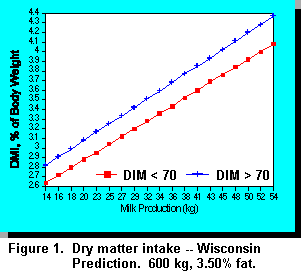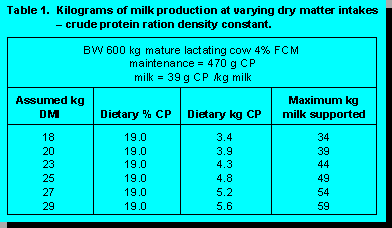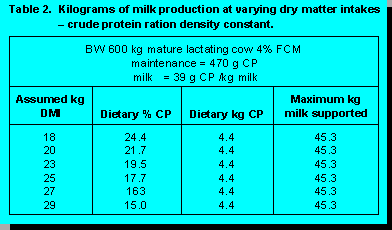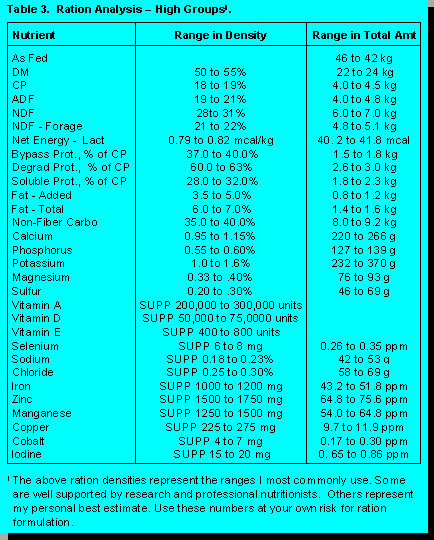 How is DMI determined? One method is to
use prediction equations based on several factors including size of animals, level of production of
milk and solids, breed, etc. There are many such equations available. The output from one
program (University of Wisconsin Extension) is shown in Figure 1. The major problem, however,
with these predictive equations is that one cannot automatically assume these DMI's are actually
occurring on the farm.
How is DMI determined? One method is to
use prediction equations based on several factors including size of animals, level of production of
milk and solids, breed, etc. There are many such equations available. The output from one
program (University of Wisconsin Extension) is shown in Figure 1. The major problem, however,
with these predictive equations is that one cannot automatically assume these DMI's are actually
occurring on the farm.
Therefore, although these prediction equations can be useful as a starting place for ration calculation, ultimately rations succeed or fail on the basis of actual DMI consumed, not on what DMI is assumed to be. All quantities of all feedstuffs consumed, not just presented, must be measured. This is difficult if not impossible to do when rations are hand-fed ("top-dressed") where the cows are able to pick one feedstuff over another or otherwise sort ingredients. Seldom also are quantities of feedstuffs weighed with any regularity or accuracy. Hence, total mixed rations (TMRs) offer advantages here in not allowing sorting or preferential consumption of feedstuffs and in allowing regular weighing of all ingredients.
Daily Requirements
 Table 1 illustrates very well the
importance of DMI. At a ration CP density of 19.0% of DMI at 25 kg will support 49 kg of
milk while a DMI of 20 kg will support 39 kg of milk per day. It is meaningless to ask "what
level of milk production is a ration balanced for?" without also defining level of DMI.
Errors occur here when DMI is assumed to be higher than actual. Ration is called
"balanced", but performance is lower than expected, often tempting one to try "secret" or
special" ingredients at great costs and little results. Here the actual DMI must be
measured and either increased (ideal) or, as is illustrated in Table 2, density of nutrients
increased.
Table 1 illustrates very well the
importance of DMI. At a ration CP density of 19.0% of DMI at 25 kg will support 49 kg of
milk while a DMI of 20 kg will support 39 kg of milk per day. It is meaningless to ask "what
level of milk production is a ration balanced for?" without also defining level of DMI.
Errors occur here when DMI is assumed to be higher than actual. Ration is called
"balanced", but performance is lower than expected, often tempting one to try "secret" or
special" ingredients at great costs and little results. Here the actual DMI must be
measured and either increased (ideal) or, as is illustrated in Table 2, density of nutrients
increased.

My personal approach however is a little different: I try to balance a high group ration for approximately 19% CP, 40% non-fibrous carbohydrates, 6 to 7% total fat and neutral detergent fiber from forage (NDF-F) at 21 to 23% (depend on forage source and "effective" fiber). Therefore, I tend not to change ration densities from one high group to another based on production, but rely instead on proper selection of cows to go into the group. At this point, I then attempt to maximize DMI. Attached is a copy of what I personally use do not accept these verbatim, but instead use them to help develop your own.

Higher milk production must be compensated over the long run by higher DMI. There is no such thing as a free lunch. The goal of every dairyman should be to maximize DMI in all production groups.